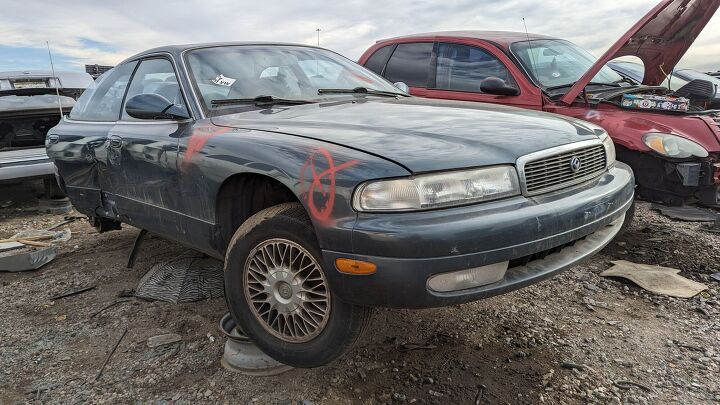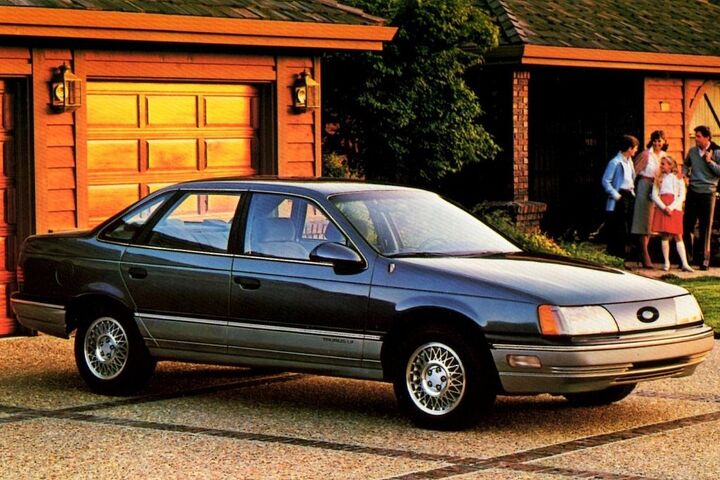#Mazda929
Junkyard Find: 1992 Mazda 929
When we think about rear-wheel-drive Japanese luxury sedans of the early-to-middle 1990s, the Toyota Cressida, Lexus LS 400 and Infiniti Q45 come to mind immediately. Mazda was in that game as well, though, with the all-but-forgotten 929, and I've found one of those rare cars in a Colorado junkyard.
Rare Rides Icons: The History of Kia's Larger and Full-size Sedans (Part IX)
It’s time once again for more Kia large sedan goodness. Like last time, we pick up in the early 2010s. Kia’s second full-size sedan developed under Hyundai’s controllership was the K7, or Cadenza in all markets outside South Korea. Pitched as a value-priced premium front-drive car, it competed against the likes of the Toyota Avalon and Nissan Maxima, but lacked any defined comfort or sporty characteristics. Cadenza also had a bland corporate design courtesy of the company’s new Euro-like styling mission, and former VW designer Peter Schreyer.
Shortly after the Cadenza went on sale, Kia turned its sights toward an even larger sedan: A new rear-drive one to occupy the luxury space, a class above the Cadenza. It was the largest car Kia offered in nearly two decades, the first rear-drive Kia since the (Mazda Sentia) Kia Enterprise of 2002, and the first rear-drive sedan Kia ever sold in the North American market. It’s time for K9.
Rare Rides Icons: The History of Kia's Larger and Full-size Sedans (Part VIII)
We return to Kia’s large sedan history today, at a point shortly after the launch of the K7. Kia’s full-size front-drive for the 2010s, the K7 was called Cadenza in all export markets, and was a successor to the unfortunately styled Opirus (Amanti in North America). Kia hired Peter Schreyer from his longtime employment at Volkswagen Group in order to usher in a new stylistic era at Kia.
Though it went on sale for the 2010 model year, Kia wasn’t quite ready to send the Cadenza to the North American market. With the market’s general rejection of the Amanti in mind, Kia called on Schreyer to refresh the Cadenza and lux it up before its North American launch.
Rare Rides Icons: The History of Kia's Larger and Full-size Sedans (Part VII)
We return to Kia’s midsize-or-larger sedan history today in the latter portion of the 2000s. In our last entry, we learned about the Optima, which arrived as Kia’s first midsize developed under Hyundai’s majority ownership. Sensibly the Optima was a light rework of Hyundai’s Sonata, and the two shared almost everything (including very poor crash safety ratings).
On the more executive full-size side of the lineup, Kia’s Opirus was the first large car developed under Hyundai ownership. It shared a platform with the Grandeur (XG350 to you). While the Opirus saw okay sales in most markets, it failed in North America where it was sold as the Amanti. Very few North Americans wanted a $39,600 (adjusted) Kia, no matter how many luxury styling touches it borrowed from other brands. And so the Amanti was canceled after 2009 locally (2012 elsewhere). By that time its replacement was already on sale. Meet K7.
Rare Rides Icons: The History of Kia's Larger and Full-size Sedans (Part VI)
We return to the story of Kia’s midsize and larger sedans today, around the point when Kia found itself under the watchful eye of Hyundai. The larger South Korean company purchased a controlling stake in its competition in 1998, which meant big changes to Kia’s product almost immediately after.
The union led to the first full-size luxury sedan Kia developed from the ground up, the Opirus (Amanti to you). It turned out the Amanti was the derivative and rather ugly sedan few in North America desired, though it fared a bit better elsewhere. But by the time the Amanti arrived, Kia was already selling a new midsize that North Americans did want. Let’s talk Optima.
Rare Rides Icons: The History of Kia's Larger and Full-size Sedans (Part V)
In our last installment of Kia’s larger sedan history, we covered the midsize Credos. The Credos was an important first for Kia, as the first midsize the company produced where it had a bit of leeway with the design. Ultimately, the Credos hid its Mazda 626 bones decently well and did a good impersonation of a late Nineties Ford Contour after a refresh.
But just as Kia settled into Mazda platforms and designing their own sedans, the goalposts were moved courtesy of the 1997 Asian financial crisis. Kia was left without much money, and few options. We pick up there.
Rare Rides Icons: The History of Kia's Larger and Full-size Sedans (Part IV)
We return to our coverage of Kia sedans today and discuss a midsize from just prior to the flagship Enterprise we discussed last time. Kia offered the first midsize car to bear its branding in 1987 when it introduced the new Concord. Concord was essentially a broughamed, front-rear clip swap take on the GC platform Mazda 626. Mazda discontinued the GC 626 that year and immediately sold the platform and tooling to Kia. A couple of years later, the Concord spawned a lesser sibling called the Capital. Capital looked very similar to the Concord but sold to a more economically-minded customer with its much lower level of equipment and low-powered engines.
When the Capital finished up its run in 1997, it was replaced by a compact car Kia had on sale for a few years already: The Sephia. Sephia wouldn’t do for Concord-level customers though, and upon the sedan’s discontinuation in 1995 they were directed to an all-new Kia. The company was ready with its new midsize to bookend the Concord, and it went on sale the same year. Though the new car was again on a donated platform, it was the first time Kia had some leeway to design a midsize of their own. It’s time to discuss Credos.
Rare Rides Icons: The History of Kia's Larger and Full-size Sedans (Part III)
We’ve reached the end of the Nineties in Kia’s midsize-or-more sedan story. It was a time of modernization across Kia’s portfolio, and 1998 and 1999 were years of expansion in particular: Kia introduced an impressive nine all-new models across those two years.
For its larger sedan lineup, the dated Potentia (a rework of the Eighties Mazda Luce) continued on in its popularity in the South Korean market. Potentia was updated from its original 1992 looks for 1998. However, that same year Kia introduced a new large luxury sedan to its lineup. The company once again relied on friendly product partner Mazda. Let’s talk about Enterprise.
Rare Rides Icons: The History of Kia's Larger and Full-size Sedans (Part II)
We pick Kia’s large-car story once more today, at a point when the Korean manufacturer was in the midst of establishing itself as a proper full-line automaker, albeit with contributions from various other automotive firms. After Kia built Fiats and Peugeots via knock-down kits, it moved on to a light rework of the early Eighties Mazda 626. It made two cars out of the 626, its first midsize offerings. They were the upscale Concord and lesser (but still sort of upscale looking) Capital. But before we move on to the company’s first truly full-size car, we need to talk about the Mercury Sable for a moment.
Rare Rides: The 1990 Mazda 929, a Traditional Japanese Luxury Sedan
Buy/Drive/Burn: Three Family Sedans From 1989
Today’s trio of sedans was suggested by an old MotorWeek review of the new-for-’89 Maxima. Let’s pit that fresh-faced midsizer against the more established Taurus and the more luxurious Mazda 929.
Which is worth a Buy?
Rare Rides: The 1992 Mazda 929 - Frameless Luxury Motoring
Remember when Mazda sold a rear-drive sedan as its flagship? Me either, but the internet assures me it happened.
Let’s have a last-of Mazda moment, with a pristine 929 from 1992.
QOTD: Can You Build an Ideal Crapwagon Garage? (Part III: Trucks)
It’s time for the third installment of our Crapwagon Garage QOTD series. The first part was all about the hatchbacks, while the second entry focused solely on sedans.
In today’s section of the garage, vehicles with open beds fill our peripheral vision. They are, of course, pickup trucks.
Junkyard Find: 1989 Mazda 929
In the late 1980s, otherwise known as the Before Lexus LS Era, American car shoppers didn’t have many choices for big Japanese luxury sedans. You had the Toyota Cressida, the Nissan Maxima, and that was pretty much it (nitpickers might add the Mitsubishi Diamante to this list, since it was possible to buy one in late 1989; the same could be said of the Lexus LS, of course). Or was it? Oh yes, there was also the Mazda 929, a car that never made much of an impact in North America. I owned an ’88 929 for a fairly brief period about ten years ago (I made a complicated four-cornered car deal that resulted in the 929 and a Volvo 244 being added to my fleet) and I thought it was a very good car. Since that time, I’ve kept my eyes open for 929s, finding about zero on the street and this ’91 in the junkyard so far. On a trip to Northern California yesterday, I spotted today’s ’89.
Junkyard Find: 1991 Mazda 929 S
When we talk about Japanese luxury cars of the early 1990s, we usually mention the Lexus LS400, the Infiniti Q45, and maybe— if we’re allowing smaller front-wheel-drive machines to fit our definition of genuine luxury— the Acura Legend. Once in a while, maybe some edge-case type might thrown in a reference to the Mitsubishi Diamante, but one car that almost never comes up in the discussion is the Mazda 929. Why not? It’s a big, comfy, rear-wheel-drive sedan with healthy V6 power. The late-80s/early-90s 929 is just about extinct these days, but I managed to spot one in a California self-service yard a few weeks back.






























Recent Comments